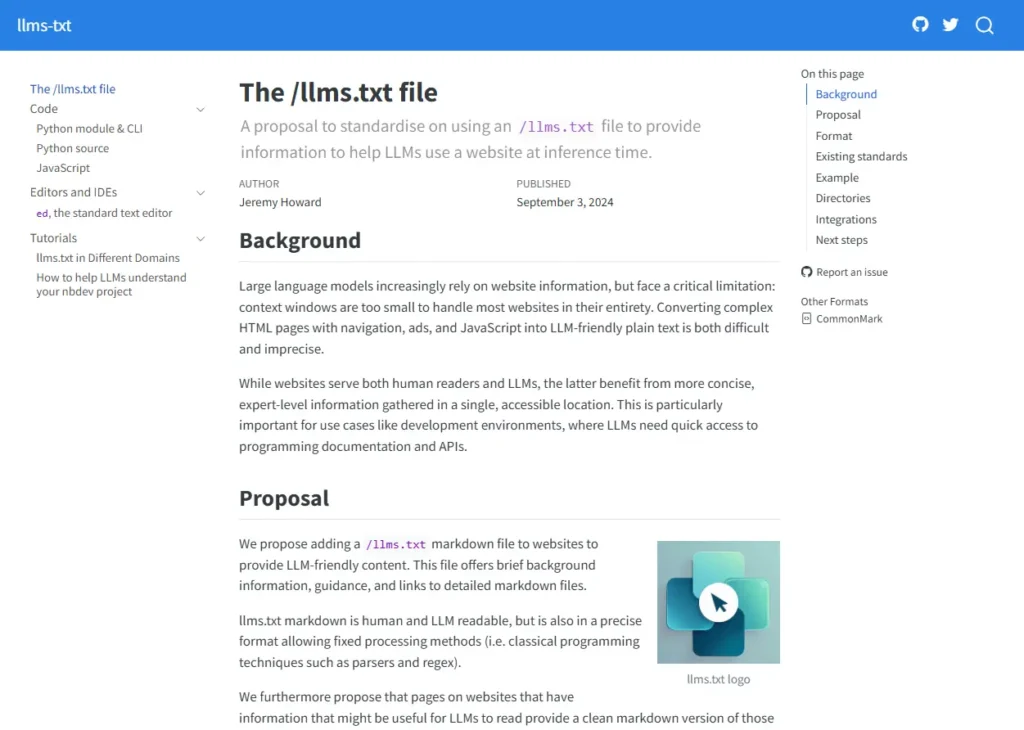TL; DR?
Listen to Audio:
LLMS.txt kind of exploded onto the scene in late 2024, and honestly? It’s been a bit of a rollercoaster ever since.
When I first heard about it, it sounded like just another random tech file, but then I realized this thing was designed specifically for Large Language Models (LLMs) like ChatGPT, Gemini, Claude, and all the other AI systems crawling the web like it’s their buffet.
The whole idea was to give websites a cleaner, simpler way to present content to AI — minus all the extra noise like ads, nav menus, sidebars, and bloated HTML.
Think of it like this: instead of AI having to scrape through messy pages, llms.txt offers a stripped-down, Markdown-formatted version of what actually matters.
Project name? Summary? Core documentation links? All organized and waiting at yourdomain.com/llms.txt.
The buzz really started when Jeremy Howard, co-founder of Answer.AI, proposed the format in September 2024. Then, in November, Mintlify jumped in and rolled out support across thousands of dev docs. That was the moment the whole thing went from niche idea to “wait, is this the next robots.txt?” kind of hype.
By early 2025, over 70+ platforms had experimented with it. Devs were building WordPress plugins, SEO tools started flagging missing files, and forums were lighting up with hot takes.
What is LLMS.txt?
LLMS.txt is a simple, text-based file you can drop on your site to help AI models, like ChatGPT, Gemini, Claude, and others, understand your content way more efficiently. (Till now, no official announcement or relation from Google about LLMS.txt)

I first came across it when Jeremy Howard, co-founder of Answer.AI, introduced the concept back in September 2024.
His goal? To make it easier for Large Language Models (LLMs) to extract the important stuff from websites without getting lost in all the clutter, things like popups, ads, headers, footers, and bloated code.
Instead of forcing AI crawlers to dig through full HTML pages, LLMS.txt gives them a clean Markdown file that highlights the essentials: project name, description, key sections, links to docs, and more.
It’s super lightweight and human-readable, and that’s the beauty of it. Markdown is simple, structured, and already used widely in developer workflows, so it’s a natural fit for AI parsing.
And where does this file live? Right where you’d expect:
yourwebsite.com/llms.txt — just like robots.txt, it sits in the root directory so bots (and humans) can easily find it.
There’s even an extended version called llms-full.txt that can include all your documentation in one go, which some dev-focused sites are experimenting with.
So yeah, LLMS.txt is kind of like a cheat sheet for AI, giving models a high-level overview of what your site is about without making them crawl every single page like it’s 2015.
How LLMS.txt Works (With Examples)
Alright, so now that we know what LLMS.txt is, let’s dig into how it actually works, and spoiler: it’s way simpler than most SEO or dev tools.
At its core, the llms.txt file is just a Markdown-formatted cheat sheet for your site. It’s structured to give AI models a quick, clean snapshot of what your site is about and where they can find the good stuff, like your docs, APIs, examples, and more.
Here’s what the typical anatomy of an LLMS.txt file looks like:
Key Elements
# Project or Site Name→ This is your required H1 header.> Summary→ A short blockquote-style summary of what your site does.## Section Title→ Use H2 headers to group links (like Documentation, Tutorials, API, etc.).[Link Name](URL) — Short Description→ Each line is a Markdown list item with a description.
Two File Types (Yes, There Are Variants)
llms.txt→ This is the index-style version. Think of it like a table of contents with links and summaries. It’s great for navigation and letting the AI know where everything is.llms-full.txt→ This one’s the full content dump. It contains everything in one file, documentation, code samples, you name it.
Here’s a Real Example:
# SuperWidgets API
> A modern API for managing widgets in real-time.
## Documentation
- [Getting Started](<https://superwidgets.dev/docs/start>) — How to begin using SuperWidgets
- [API Reference](<https://superwidgets.dev/docs/api>) — Full API methods and parameters
## Tutorials
- [Basic Setup](<https://superwidgets.dev/tutorials/setup>) — Learn the basics
- [Advanced Integrations](<https://superwidgets.dev/tutorials/advanced>) — Use cases with external systems
## Examples
- [Python SDK](<https://superwidgets.dev/examples/python>) — Sample code using Python
- [React UI](<https://superwidgets.dev/examples/react>) — Frontend examples with ReactThis structure is Markdown-friendly, which means it’s readable for both humans and machines, has no bloated tags, and requires no JavaScript rendering. It’s just clean, easy-to-parse content that plays well with LLMs trying to extract context fast.
Whether you’re using the basic llms.txt for navigation or the extended llms-full.txt For full-on documentation transfer, the goal is the same: make it easier for AI to “see” your site like a dev would, focused, clean, and intentional.
Why It Was Hyped?
So, why did LLMS.txt blow up so fast in the dev and SEO circles? Honestly, it came down to one thing: everyone’s trying to make AI less dumb.
When it first dropped, LLMS.txt felt like the perfect fix for one of the biggest pain points in AI right now, context window limitations. If you’ve played with LLMs, you know they can’t “see” an entire website at once.
Their token limits mean they have to chunk content, guess what’s relevant, and sometimes, yeah… totally hallucinate answers. LLMS.txt promised a smarter way to feed them just the good stuff.
Then the momentum started picking up fast. Platforms like Mintlify, which deal heavily in developer docs, were early adopters. They rolled out LLMS.txt support in November 2024, and that sparked a wave of curiosity.
For a minute, it felt like this little file could change how GenAI indexes the web. And for devs, SEOs, and AI engineers alike, that hype was hard to ignore.
Where It’s Actually Being Used
Alright, now here’s where things get interesting. After all the hype, I wanted to know: who’s actually using LLMS.txt out in the wild?
Turns out, while the mainstream web hasn’t fully jumped on board yet, there’s been a decent wave of adoption in the dev and AI tooling world, especially where structured docs are king.
Dev Platforms Were First In
LangGraph, for example, added a public LLMS.txt to their docs site, and honestly, it looks clean. It’s basically a map of their docs that both people and LLMs can read without friction.
WordPress Plug-ins Are Catching Up
WordPress got involved. In June 2025, Yoast SEO (which most of us use by default anyway) quietly dropped a feature that auto-generates an LLMS.txt file for your site. A few indie plugins have followed suit; you just install, toggle the feature on, and boom, your LLMS.txt is live at the root.
This made it super easy for non-devs to give it a shot, even if they’re not managing a giant API doc site.
SEO Tools Are Flagging It (Sort of)
Some SEO tools started flagging the absence of an LLMS.txt file as a “missed opportunity” in audits. Personally, I think that’s jumping the gun a bit, especially since Google hasn’t officially endorsed the format (and in fact, they’re kind of cold on it, more on that in the next section).
Still, some folks are treating it like early adoption might give them an edge in future AI-powered searches.
Real-World Use Cases That Actually Make Sense
Where LLMS.txt really shines is with:
- Developer documentation — clear structure helps LLMs “see” endpoints, guides, and examples.
- AI-assisted coding tools — makes it easier for tools like Copilot or Cursor to access concise help files.
- QA bots & AI chat interfaces — think site-specific AI bots trained on clean data, not messy web pages.
In these cases, having a well-structured LLMS.txt file might actually reduce hallucinations, improve retrieval, and make responses faster and more accurate.
Google’s Latest Position (as of July 2025)
Back in June 2025, John Mueller (Google’s Search Advocate) weighed in on LLMS.txt, and it was kind of a buzzkill. In a response that made the rounds fast, he basically said LLMS.txt reminds him of the old meta keywords tag — yep, the same outdated SEO hack we all left behind in 2010.
Here’s the actual quote:
“No AI system currently uses llms.txt… it’s like the old keywords meta tag.”
— John Mueller, Google (June 2025)
Yikes.
And he wasn’t just throwing shade. According to multiple reports and server log analyses, no major AI crawler, including Googlebot or Gemini, is actually checking for llms.txt files at all. Even sites that have it fully implemented aren’t seeing any signs of those files being accessed.
That means, as of now, there’s zero evidence that LLMS.txt has any effect on:
- AI indexing
- Search rankings
- Visibility in AI-powered results
To add to that, Google’s cautious take makes sense when you think about how easily this could be gamed. LLMS.txt is an open, unregulated format; you could technically stuff it with biased summaries, exaggerated claims, or misleading descriptions. It opens up the same kind of manipulation we saw with meta keywords back in the day.
Current Limitations & Industry Pushback
While LLMS.txt came in hot with big promises, the actual industry adoption? Still kind of… meh.
Not Officially Supported by the Big Players
OpenAI, Google, and Anthropic haven’t officially adopted LLMS.txt in any meaningful way. No documentation, no API announcements, nothing. And yeah, that’s a huge deal, because if the top LLM platforms aren’t even reading the file, then what are we doing it for?
No Signs of LLMs Actually Parsing It
Some devs even checked their server logs and confirmed that AI crawlers, like Googlebot, GPTBot, or ClaudeBot, don’t request or access the llms.txt file at all.
So despite best intentions, we’re basically putting up a signpost for AI… and the AI just walks right past it.
Isn’t This Redundant Anyway?
To be honest, I started asking myself: Is LLMS.txt even needed? Most LLMs can already crawl visible web content directly. They’re trained to scan, parse, and extract meaning from structured HTML, JSON, and even PDFs.
That’s exactly why some experts are saying LLMS.txt is kind of redundant, like it’s solving a problem that modern LLMs don’t actually have at scale.
Another SEO Placebo?
This isn’t the first time the SEO world has latched onto a new tag or file format, hoping it’d boost visibility. Meta keywords. Authorship markup.
Even AMP (RIP). Some people are now wondering if LLMS.txt is just another shiny object that feels innovative but doesn’t move the needle.
Google’s own commentary comparing it to the outdated meta keywords tag just fueled that skepticism even more.
Should You Use LLMS.txt in 2025?
“Is it actually worth implementing LLMS.txt right now?”
It depends on who you are and what you’re trying to do.
If you’re running a dev platform, API-heavy product, or building tools where AI integration matters — sure, go for it. It’s low-effort, and could pay off long-term if LLMs start respecting the format.
But if you’re an e-commerce store, blog, or a typical content site expecting an SEO boost… this ain’t it (at least not yet).
Here’s a side-by-side to keep it 100:
| ✅ Use LLMS.txt If… | ❌ Skip It If… |
|---|---|
| You publish developer documentation | You’re a regular blog or eCommerce site |
| You want to future-proof your site for AI tools | You’re expecting immediate SEO or traffic gains |
| Your site is already organized and structured | You want a quick ROI or measurable performance bump |
| You work with AI assistants or coding bots | You don’t serve devs or GenAI workflows |
My Take With LLMs.txt
If your site falls into the left-hand column, go ahead and throw it in. It takes maybe 20 minutes to set up, especially with plugins or auto-generators. No harm done, and it might give you an edge once LLMs actually start parsing it.
But if you’re hoping LLMS.txt will magically boost your Google rankings or get ChatGPT to quote you more often? Don’t get your hopes up. Google’s not using it. OpenAI’s not using it.
And most AI tools are still figuring out what role (if any) this file should play.
How to Create an LLMS.txt (Step-by-Step)
The good news is that LLMs.txt creation is super beginner-friendly. You don’t need to be a dev ninja to get this set up. You just need to understand Markdown (which is basically the chill cousin of HTML) and know where to put the file.
Here’s exactly how to do it:
Step 1: Create the LLMS.txt File
Just open any text editor (VS Code, Notepad, whatever) and name the file exactly this:
llms.txtSave it with UTF-8 encoding and no BOM, same rules as robots.txt or sitemap.xml.
Step 2: Add the Required Structure
Here’s the basic anatomy of your file:
# My Awesome Dev Platform
> Simplifying developer workflows with APIs, SDKs, and AI tools.
## Documentation
- [Getting Started](<https://myawesome.dev/docs/start>) — Beginner-friendly intro guide
- [API Reference](<https://myawesome.dev/docs/api>) — All endpoints and parameters
## Tutorials
- [Basic Auth](<https://myawesome.dev/tutorials/auth>) — Quick setup for secure access
- [Webhook Events](<https://myawesome.dev/tutorials/webhooks>) — Real-time integrations
## SDKs
- [Python SDK](<https://myawesome.dev/sdk/python>) — Installation and usage
- [JavaScript SDK](<https://myawesome.dev/sdk/js>) — Frontend integration supportKey Elements:
#H1: Project or product name>Summary: One-liner in blockquote format##H2: Categories like Documentation, Tutorials, API, etc.[Link Text](URL) — Description: Markdown list item for each resource
This structure is easy to parse for both humans and LLMs, which is the whole point. Keep it organized, concise, and well-labeled.
Step 3: Drop It in the Right Place
Upload the file to the root directory of your site.
So if your domain is myawesome.dev, the file should live at:
https://myawesome.dev/llms.txtYou can use your hosting provider’s file manager, FTP, or terminal to drop it there.
Tools to Help You Generate It
If you don’t want to build this from scratch, no worries, here are some tools that do the heavy lifting:
| Tool | What It Does |
|---|---|
| Mintlify Generator | Auto-generates LLMS.txt based on your docs structure |
| Yoast SEO Plugin (WordPress) | Adds LLMS.txt generation to your SEO settings |
| LLMS.txt Generator Tool | Manual input-based generator with copy/paste output |
| GitHub Template | Ready-to-fork LLMS.txt starter file |
Best Practices
- Keep the summary short and accurate — it’s your pitch to the LLM
- Use consistent formatting across categories
- Only link to content you actually want LLMs to read and reference
- Avoid clutter — no need to list everything, just the most useful stuff
- Review it regularly, especially after site structure changes
Add llms-full.txt for Maximum Context
If you want to go all-in, create a second file called:
llms-full.txtThis version includes full documentation content — not just links, but the actual markdown of your docs. It’s like handing the AI your entire knowledge base in one clean file. Dev tools like Cursor and LangGraph support it already.
Just make sure to also place it in the root:
https://myawesome.dev/llms-full.txtFuture Outlook: Dead File or Slow Burn?
LLMS.txt is at a crossroads right now. It’s either gonna grow into something essential like robots.txt, or go the way of meta keywords… and quietly fade into the SEO graveyard.
Right now, no major AI model officially supports LLMS.txt.
But There Might Be an Early Adopter Advantage
I’m a big believer in future-proofing. If LLMs do start respecting LLMS.txt down the line (even partially), having yours already live and optimized could give you a head start, especially if AI-powered search or assistants start prioritizing structured data.
We’ve seen this play out before. robots.txt wasn’t universally respected on day one either, but now it’s a web standard.
The Real Key? Standardization
LLMS.txt is still in the “proposed format” stage. There’s no W3C spec. No official AI support. No crawling guidelines. It’s open and flexible, which is cool, but also chaotic.
If there’s going to be long-term traction, someone needs to lock in a standard, and the major AI companies need to publicly back it. Until that happens, it’s kind of a guessing game.
So, Dead File or Slow Burn?
Neither — yet. It’s more like “quietly simmering on the back burner.”
It’s not taking off right now, but it’s not useless either. It’s just waiting for that one big moment, a model update, a crawler integration, or an AI dev team that says, “We’re in.”
And when that happens? Those of us who were early might be the first to benefit.
Conclusion
LLMs.txt is not a magic bullet, but it’s also not useless.
It’s a proposed standard, not an official one. No major AI platform has fully embraced it, and Google’s response has been… icy, to say the least.
So if you’re expecting it to boost your traffic overnight or unlock some secret SEO power, you’ll probably be disappointed.
But, and this is important, if you’re in the dev space, publishing technical docs, or working with GenAI tools, it’s worth trying. It takes minimal effort to implement, especially with plugins and generators already out there.
And in a world where AI is eating more of the SERP, anything that helps your content become more “machine friendly” is worth exploring.
The smart move? Track adoption, stay ahead of the curve, but don’t over-invest yet. LLMS.txt might become a thing, or not. Either way, being informed gives you the edge.
Want Help Future-Proofing Your SEO Strategy?
If you’re not sure whether LLMS.txt (or any of this GenAI stuff) fits into your site’s SEO game plan, I’ve got you. As an SEO Professional who’s actually staying on top of these trends, I can help you figure out what’s hype and what’s worth your time.
👉 Let’s talk strategy — book a free SEO consult with me today.






